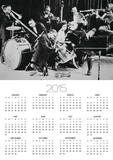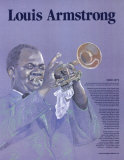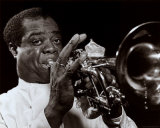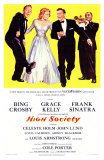Louis Armstrong Posters, Jazz Musician & Entertainer: Educational Posters, Books, DVD, CD, Links for Learning
|
||||||||||||||||||||||||||||||||||||||||||||||||||||||||
|
social studies > black history > LOUIS ARMSTRONG < famous men |
||||||||||||||||||||||||||||||||||||||||||||||||||||||||
|
Jazz musician and entertainer Louis Armstrong posters and prints images include the “Great Black Americans” poster series and art prints of photos from his music career. |
||||||||||||||||||||||||||||||||||||||||||||||||||||||||
“What we play is life.” Louis Armstrong Louis Armstrong: An Extravagant Life by Laurence Bergreen - Louis Armstrong grew up in conditions of dire poverty, got the bulk of his musical training in a New Orleans reformatory, and managed, by dint of his spectacular and intuitive genius, to transform the music of our century. The author has dug into the trumpeter’s archive of scrapbooks, letters, diaries, and tape-recorded reminiscences; the result is an eminently readable narrative. Louis Armstrong, in His Own Words: Selected Writings by Louis Armstrong - introduces readers to a little-known facet of this master trumpeter, band leader, and entertainer. Based on extensive research through the Armstrong archives, this important volume includes some of his earliest letters, personal correspondence with one of his first biographers in 1943-44, autobiographical writings, magazine articles, and essays. Here are Armstrong’s own thoughts on his life and career-from poverty in New Orleans to playing in the famous cafes, cabarets, and saloons of Storyville, from his big break in 1922 with the King Oliver band to his storming of New York, from his breaking of color barriers in Hollywood to the infamous King of the Zulus incident in 1949, and finally, to his last days in Queens, New York. Along the way Armstrong recorded touching portraits of his times and offered candid, often controversial, opinions about racism, marijuana, bebop, and other jazz artists such as Jelly Roll Morton and Coleman Hawkins. Indeed, these writings provide a balanced portrait of his life as a musician, entertainer, civil rights activist, and cultural icon. Armstrong’s idiosyncratic use of language and punctuation have been preserved to give the reader an unvarnished portrayal of this compelling artist. This volume also includes introductions to the writings, as well as an annotated index of names and places significant to Armstrong’s life. Satchmo: The Genius of Louis Armstrong by Gary Giddins - “A valuable, jubilant look at a great man and artist.” -New York Times Book Review Gary Giddins has been called “the best jazz writer in America today” (Esquire). Louis Armstrong has been called the most influential jazz musician of the century. Together this auspicious pairing has resulted in Satchmo, one of the most vivid and fascinating portraits ever drawn of perhaps the greatest figure in the history of American music. Available now at a new price and size, this text-only edition is the authoritative introduction to Armstrong’s life and art for the curious newcomer, and offers fresh insight even for the serious student of Pops. Louis Armstrong & King Oliver - Audio CD If I Only Had a Horn: Young Louis Armstrong by Roxane Orgill - 4 - 8 year olds. Louis Armstrong: Satchmo (1990) video/dvd All-Time Greatest Hits -Louis Armstrong; Audio CD The Story of Jazz (1991) video/dvd Jazz - A Film by Ken Burns (2000) video/dvd - The 10-part musical journey celebrating Jazz’s soaring achievements, from its origins in blues and ragtime through swing, bebop, and fusion. 75 interviews, more than 500 pieces of music, 2,400 still photographs, and over 2,000 rare and archival film clips spotlights many of America’s most original, creative–and tragic–figures, including Louis Armstrong, Jelly Roll Morton, Duke Ellington, Benny Goodman, Billie Holiday, Charlie Parker, and Miles Davis. LINKS FOR LEARNING : LOUIS ARMSTRONG |
||||||||||||||||||||||||||||||||||||||||||||||||||||||||
|
|
|
|
|
NPW home | Global PathMarker Collection | APWTW Blog | faqs-about | contact | search | privacy |
|
NetPosterWorks.com ©2007-2015 The Creative Process, LLC All Rights Reserved. |
last updated












